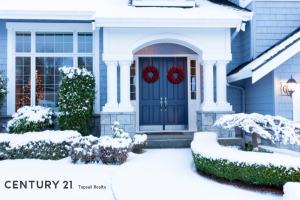Preparing Your Home for Winter: Essential Tips for Northeast Homeowners
 As the crisp autumn air settles in and the leaves begin to fall, homeowners in the Northeast know that winter is just around the corner. The cold, snowy months can take a toll on homes, but with proper preparation, you can safeguard your property and ensure a warm, comfortable, and energy-efficient winter season. Here’s a checklist to help you get your home winter-ready.
As the crisp autumn air settles in and the leaves begin to fall, homeowners in the Northeast know that winter is just around the corner. The cold, snowy months can take a toll on homes, but with proper preparation, you can safeguard your property and ensure a warm, comfortable, and energy-efficient winter season. Here’s a checklist to help you get your home winter-ready.
1. Inspect and Service Your Heating System
Your home’s heating system is essential for keeping you warm during the cold months. Before the first freeze, have your furnace or boiler inspected by a professional. This inspection can prevent breakdowns and ensure your system is operating at peak efficiency. Don’t forget to change or clean the air filters and consider having your chimney swept if you use a wood-burning fireplace.
- Tip: If you have a programmable thermostat, set it to a lower temperature during the day when you’re not home to save on energy bills.
2. Seal Windows and Doors
Drafty windows and doors can let cold air in and allow warm air to escape, driving up your heating costs. Inspect the seals around your windows and doors for gaps, cracks, or worn-out weatherstripping. Apply fresh weatherstripping and caulk any cracks to ensure an airtight seal.
- Tip: Install door sweeps on exterior doors to prevent drafts from entering beneath them.
3. Clean Gutters and Downspouts
Fallen leaves and debris can quickly clog your gutters, which can lead to ice dams when snow melts and refreezes. Clean your gutters and downspouts to ensure proper drainage. Water that doesn’t drain correctly can cause roof leaks or damage to your foundation.
- Tip: Consider installing gutter guards to prevent future blockages and make next year’s cleanup easier.
4. Check the Roof
Snow and ice accumulation can be tough on your roof, so make sure it’s in good condition before winter sets in. Inspect your roof for missing, damaged, or loose shingles and have them replaced. While you’re at it, check the flashing around chimneys and vents to ensure they are properly sealed.
- Tip: Trim any tree branches that hang over your roof to prevent snow-laden limbs from breaking and causing damage.
5. Insulate Pipes
In the Northeast, frozen pipes are a common winter issue. Insulate any exposed pipes in unheated areas, such as the basement, attic, or garage, to prevent them from freezing and bursting. Foam pipe insulation or heat tape can provide an extra layer of protection.
- Tip: On especially cold nights, let faucets drip slightly to keep water moving and reduce the risk of freezing.
6. Prepare for Snow and Ice
Ensure that you’re ready to tackle snow and ice removal before the first winter storm hits. Stock up on snow removal tools like shovels, ice melt, and, if necessary, service your snowblower. Also, keep an eye on pathways, stairs, and driveways to prevent ice buildup that can lead to slips and falls.
- Tip: Apply a coat of sealant to your driveway or walkways before winter to help protect them from cracking under freezing conditions.
7. Test Smoke and Carbon Monoxide Detectors
During the winter, homes are often sealed up tightly, and heating systems run for extended periods, increasing the risk of fire or carbon monoxide buildup. Check and replace the batteries in your smoke and carbon monoxide detectors to ensure they are functioning properly.
- Tip: Test your detectors monthly and consider installing new units if they are more than 10 years old.
8. Reverse Ceiling Fans
This might seem like a minor detail, but it can make a big difference in your home’s warmth and energy efficiency. Reverse the direction of your ceiling fans so they run clockwise during the winter. This will push warm air from the ceiling back down into the room, helping to maintain a comfortable temperature.
- Tip: Keep the fan on a low setting to avoid creating a strong breeze.
9. Inspect Insulation
Proper insulation is key to keeping your home warm in the winter and lowering your energy bills. Check the insulation in your attic, walls, and basement to ensure it’s adequate. Adding extra insulation where needed can improve your home’s overall energy efficiency.
- Tip: Consider insulating your attic access door to prevent heat loss through this often-overlooked area.
10. Winterize Outdoor Spaces
Don’t forget your outdoor areas! Drain and store garden hoses, shut off exterior water faucets, and bring outdoor furniture inside or cover it to protect it from the elements. If you have a pool or irrigation system, ensure they are properly winterized to avoid damage from freezing temperatures.
- Tip: If you have potted plants that can’t survive the cold, bring them indoors or into a sheltered area.
Conclusion
Preparing your home for winter in the Northeast might seem like a daunting task, but a little effort now can save you from costly repairs and discomfort later. By following these steps, you’ll protect your home, improve energy efficiency, and enjoy a cozy, hassle-free winter season. Start checking off these tasks today, and you’ll be ready to embrace the cold months with peace of mind.


 Facebook
Facebook
 X
X
 Pinterest
Pinterest
 Copy Link
Copy Link

